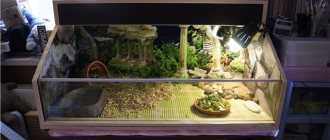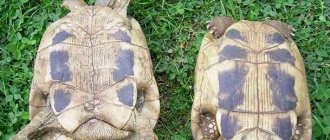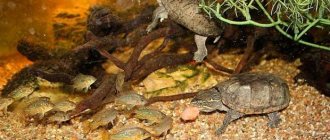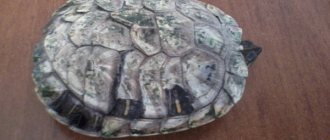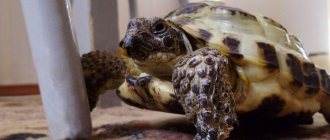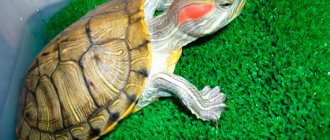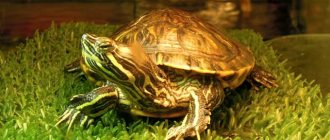Errors
- Feed your reptile too often. This will cause overeating and indigestion.
- The reptile body is adapted to consume a certain type of food. You cannot feed a herbivore only meat, and a carnivore only fruits and vegetables.
- Giving your pet food too rarely. The individual will be weak, lethargic, inactive and susceptible to disease.
If you follow the rules of feeding land reptiles, they will have good health and longevity.
Previous Inhabitants Let's look at what crayfish eat at home Next Inhabitants About keeping and caring for a land turtle from A to Z
Diet in the wild
Land turtle - how to care for it at home
The basis of the diet of land reptiles is plant food. It contains all the nutritional components they need. Turtles prefer:
- green leaves;
- fruits;
- fresh berries;
- green grass;
- young shoots of plants.
Some species of turtles try to diversify their diet and supplement it with proteins. To do this, they attack bird nests built on the ground and steal eggs laid from them. These reptiles do not hunt other living creatures, as they are very slow and are unlikely to be able to catch up with anyone.
Home Diet Basics
At home, a land turtle does not have the opportunity to independently choose food, obtaining those products that its body needs at a particular moment. In addition, natural instincts are gradually dulled, which is manifested, for example, by the fact that it begins to absorb earth and small stones. Therefore, the owner of the reptile is responsible for the correct and balanced diet of the pet.
The most correct diet would be the following ratio of products:
- herbs, greens - up to 75-80%;
- vegetable and fruit crops, berries - 10-15%;
- cereals, seeds, bread - up to 5%;
- vitamin supplements, micro- and macroelements, animal proteins, amino acids - up to 5%.
As herbs, the greatest preference should be given to the following plant crops:
- dandelion and lettuce (leaves);
- beans, peas, beans (stems and leaves);
- alfalfa;
- plantain;
- clover;
- parsley;
- aloe;
- lawn forbs;
- thistle;
- sorrel;
- sprouted wheat and oat sprouts;
- some flowering plants.
All types of land reptiles love vegetables:
- pumpkin pieces;
- fresh chopped carrots;
- small leaves of young cabbage;
- mature chopped zucchini, squash, cucumbers;
- radishes and beets - only in young fresh form.
It is advisable to give your pet pieces of apples or pears every day, and occasionally watermelon, strawberries, strawberries, raspberries, currants, peaches, and apricots.
As a protein component, you can give both worms, insects, snails, and small pieces of boiled or raw meat.
An approximate menu for the day might look like this (in grams):
- sprouted sprouts (for example, wheat) - 50;
- raw young beets, chopped - 30;
- chopped white cabbage leaves - 30;
- chopped boiled potato tubers - 30;
- raw minced beef or chicken or earthworms - 5-10;
- pieces of wheat bread - 25;
- fish oil, vitamins, microelements - 1-3.
At least once a week, the diet includes small quantities of seaweed, various bran, sunflower seeds, yeast, soybeans, mushrooms, and ready-made nutritional mixtures.
Central Asian turtle: care, feeding
For those steppe reptiles that live in the house, the basis of the diet should be plant food, and not very juicy. Regular grass and hay are best absorbed
Vegetables, berries and fruits are possible, but be careful. Why? Do turtles get a lot of sweet fruits in nature? Only if he wanders into some garden, by chance
Therefore, at home, let such food make up no more than 15% of the total food. Typically, these turtles like lettuce, carrot tops, dandelions, and plantains.
Food should be in a place accessible to her every day, and she will decide for herself what and when to eat. You cannot give her leftovers from your plate, even with great love for her. It is not advisable to hand feed; let your pet have its own bowl and a separate corner for food.
Why exactly the Central Asian turtle?
This often happens if parents are not sure that their child will be able to care for more demanding pets, but would like to give them a chance to try themselves as young naturalists.
For children, keeping animals and caring for them is very useful: the child develops responsibility and receives indelible impressions.
Turtle and child
Children are very interested in taming a turtle, winning its trust and love. The reptile can recognize family members and choose its favorite among them. He loves affection and allows himself to be petted. Her leisurely, careful movements calm the nervous system and give pleasant emotions.
Turtle's relationship with people
You can feed the turtle by hand. She communicates with a person using body movements:
- Asks for food by shaking his head or raising his front paw;
- She scratches with her paws, demanding to be let out for a walk.
Over time, the owner and pet understand each other perfectly without words. An animal can stretch its head when greeting a familiar person, or follow its favorite around the house or apartment.
You can pet the turtle
In the warm season (at temperatures above 20˚C), you can walk with turtles outside. It is interesting to watch how she happily plucks the grass at first.
Summer walk on the lawn
And then a reptile that has mastered itself may surprise you with its curiosity and agility.
Caring for a Central Asian turtle at home
To maintain water balance, the Central Asian steppe tortoise needs a bath once a week. To do this, fill the bath with warm water at 25°C to a level of 5-7 cm, just up to the reptile’s neck. The turtle is immersed in it for 15-30 minutes, during which time it drinks and absorbs moisture through the skin. The procedure replenishes the water-salt balance of the body and improves intestinal function. In the bath, the reptile first flounders, then blissfully freezes, drinks water, and defecates. Then the individual is washed; it must be removed when it itself tries to leave the container.
Sometimes the turtle asks to hibernate - refuses food, behaves sluggishly. The process is harmful for her, caused by a discrepancy between temperature conditions and natural ones. A Central Asian tortoise living in captivity should not hibernate, otherwise it may wake up already sick. To avoid wintering, you need to increase the temperature in the terrarium and increase the frequency of bathing.
What to feed the Central Asian turtle at home?
When kept in an apartment, turtles need a varied plant menu. Approximate portion:
- Greens come first - up to 85%. Suitable for this: lettuce, lettuce, dandelions, coltsfoot, clover, plantain, alfalfa, sorrel. In winter, dry grass and hay, dried fruits are used.
- 10% of the diet is vegetables: pumpkin, carrots, zucchini, beets, radishes.
- 5% of food should be fruits - apples, bananas, pieces of melon, watermelon, as well as strawberries, raspberries, cherries.
- To support the shell, calcium supplements are added to the food.
Variety is the key to a turtle’s health; it needs to be given more different foods. It is prohibited to use bread, meat, milk, cottage cheese, eggs and other “human” food for pets. Young individuals are fed daily, adults – once every 2-3 days. The amount of food is approximately 1/2 of the size of the shell. It is better not to feed the Central Asian turtle by hand, but to put the food in special containers.
Content Features
Aquatic turtles - types, description, care and habitats
People who decide to keep such reptiles should familiarize themselves with useful information about caring for Central Asian land turtles.
Terrarium is the best design for keeping turtles
Choosing a container for keeping
It is necessary to keep reptiles at home in a special aquarium or terrarium. When choosing a container for turtles, you need to pay attention to the following parameters:
- Dimensions. It is very important that the chosen terrarium is suitable in size and has enough free space. The minimum length is 70 centimeters and the width is 60 centimeters.
- Material of manufacture. It is necessary to choose a terrarium that is made of transparent material that will allow you to observe the life of domestic reptiles. It is recommended to choose products made of organic glass. It is quite light, shock-resistant and reliable.
- Availability of ventilation holes. The terrarium must have holes for ventilation. They should be located on the side walls of the structure or on the top cover.
- Incandescent lamps. The terrarium must be equipped with additional incandescent lamps. They are needed to maintain the optimal temperature inside.
Important! The terrarium should not be too high. A height of 20-25 centimeters is sufficient.
How to properly care
Keeping Central Asian turtles is a rather difficult task, since they need to be properly cared for.
Bathing is the main procedure for caring for turtles
When caring for reptiles, the following procedures must be followed:
- Cleaning the terrarium. It is necessary to regularly clean the inside of the terrarium in which the turtles live. At least twice a week, waste products are removed. Also, during cleaning, you need to thoroughly wash the dishes that are used to feed the turtles.
- Bathing. Turtles kept at home must be bathed daily. To do this, water heated to room temperature is collected in a separate container. Then the turtle is placed in the filled container and left there for 30-40 minutes. After finishing bathing, you need to take it out and dry it thoroughly with a dry towel.
- Trimming nails. Reptiles' claws need to be trimmed every month. If this is not done, they will grow to such a size that it will be difficult for the animal to move.
Basic information about musk turtles
The homeland of these reptiles is the USA, but they have spread not only to the southeastern part of the States, but are also found in Canada. Turtles choose reservoirs with fresh water, sandy or muddy bottoms as their habitat. They spend most of their lives in water, and some reptiles are covered with a thick layer of algae. They are more active in the evenings and at night, at which time they slowly explore the bottom of the reservoir, looking for something edible.
Musk turtles are small representatives of their order; the average size of their oval carapace is 8-10 cm. Large (up to 14 cm) reptiles are rarely found. Juveniles have 3 longitudinal ridges on their armored shield. It is almost impossible to distinguish a male from a female among young animals, but in mature reptiles it is not difficult. Males have a shortened plastron, a long tail, and spine-like scales covering the inner surface of the hind limbs.
The main diet of turtles consists of small fish, mollusks, insects and plants. But they also do not disdain to taste carrion, which makes reptiles excellent orderlies of reservoirs. Individuals mate only in an aquatic environment, and lay eggs in holes; this occurs from April to the first summer month. Egg maturation lasts from 8 to 14 weeks, but this requires a certain air temperature - from 25° to 29°C.
Despite their modest size and harmless appearance, musk turtles are quite warlike reptiles. If you catch such an individual from a reservoir, it will break out in every possible way, bite, and scratch. In addition, it has another protective agent - musk glands, which emit a pungent odor in times of danger. In captivity, these animals live about 2 decades or longer.
Keeping a turtle in a terrarium
A turtle, even a land turtle, should not live freely or in a box; it requires more comfortable conditions - a spacious 60-100-liter terrarium, the width of which must accommodate at least three reptiles. Naturally, only one individual should live in such a container. Humidity should be between 70-80%. It is important that there are two corners in the tank - warm and cool:
- Warm . Can be equipped by installing an electric lamp with a power of 40-100 W. The air temperature must be stable - not lower than 25° and not higher than 35°C. To prevent the turtle from getting burned, the lighting device should be installed no lower than 15-20 cm from the bottom of the tank.
- Cold. In this area the temperature should be lower than in the rest of the container, but not lower than 20°C. Daylight hours for a reptile should last at least 10-12 hours. It is advisable to turn off the lighting at night.
Like other turtles, Central Asian land turtles need ultraviolet light - the rays provide the animal with vitamin D3, which is involved in the full absorption of calcium. Therefore, it is worth taking care of a UV lamp, the spectrum of which is UVB 10%.
Priming
Representatives of this breed love to dig in the ground - they do this often and with special diligence, so it is better to cover the bottom of the tank with a 15-centimeter layer of soil material - sand, hay, wood chips, small pebbles or garden soil. It is recommended to mix pebbles with peat. You can also place a certain amount of large pebbles and stones in the terrarium - your pet will use them to grind down stones.
Plants
Due to the constant tearing of the soil, vegetation often suffers and dies. To decorate a turtle’s home and provide its inhabitants with fresh herbs, you can sow a strip along the walls of the tank with cereals - oats or wheat.
Water tank
The land turtle does not need a body of water to swim. It is enough to install a drinking bowl, carefully securing it, and a small container in which the reptile could take a bath. It is important to adhere to the basic rules:
- The container should be sunk into the ground - this will prevent it from turning over and will make it easier for your pet to climb over it.
- The water level should reach the reptile up to half the height of the carapace.
- The water must be constantly changed - the turtle will not bother itself and leave the impromptu bath to “go to the bathroom” - everything will end up in the tank. Swimming in water containing feces can cause illness in your pet.
Why bathe a turtle?
Bathing stimulates the intestines and replenishes the water-salt balance of the animal’s body. She can drink the water she is in. When swimming, salts are often released into turtles, and this is very good. In simple terms, the presence of salts means that the kidneys are working normally. Salts in the urine are formed only in turtles, which naturally live in dry places.
To bathe a turtle, it must be placed in a basin or other container with warm water 30–35°C from the tap (if water is poured without a thermometer, then it should feel barely warm. For example, 36-37°C is warm for a person , but the turtle is already hot).
Nutrition of turtles in winter
In the summer there is a lot of fresh vegetation, but what can you feed turtles at home in winter? There are several alternative ways to feed your animal on frosty days. You need to prepare for winter in advance and check whether the reptile in captivity will eat dried or frozen foods.
Methods for preparing food for the winter:
- Drying. Before drying, plants should be thoroughly rinsed and watered. Then spread them in one layer on paper in a warm, ventilated place without foreign odors. It is best to dry plants on hot summer days in an open space.
- Freezing. In this case, the plants also need to be washed under running water and dried a little. Then place them in the freezer, after distributing them in portions into bags.
- A good, but labor-intensive way is to plant plants. Many seeds can be easily purchased at garden centers or ordered online. For example, you can plant dandelions and mint in flower pots. Also, turtles will not refuse indoor plants: tradescantia, hibiscus.
- Growing plants in aquariums. You can purchase a small aquarium in which you will need to propagate plants for reptiles to eat. You can plant various ferns, mosses, and propagate duckweed.
You can feed your turtle seeds in winter. These can be seeds of basil, clover, alfalfa, lemon balm, arugula, chamomile, oregano, thyme.
What to feed your turtle?
In the wild, turtles get their own food. They feed on various algae, grass, roots and berries. At home, the owner’s task is to provide the pet with a diet that includes vitamins and minerals that are beneficial for growth and development.
You can feed your turtle:
- Greens: clover, wheat germ, dandelions, coltsfoot, parsley, lettuce, tradescantia, aloe.
- Vegetables: carrots, cabbage, peas, pumpkin, zucchini, cucumbers, tomatoes, beets.
- Berries: cherries, currants, raspberries, grapes, strawberries.
- Fruits: apricots, bananas, plums, oranges, apples, tangerines, pears.
fruits are cut into small pieces
Your pet's diet should include protein foods. These could be slugs, worms or boiled meat. Do not feed pet cockroaches or crickets to your turtle. You can buy red worms for them at the pet store.
Approximate daily diet for a land turtle:
- any fresh sprouted greens (parsley, oats, etc.) – 50 g;
- fresh beets – 30 g;
- cabbage leaves – 30 g;
- fresh carrots – 20 g;
- boiled potatoes – 30 g;
- minced meat – 5 g;
- white bread – 20 g;
- vitamin supplement (fish oil or other) – 1 g.
It is recommended to give your pet additional food once a week. It includes the following products:
- dry seaweed;
- bran;
- raw sunflower seeds;
- dry yeast;
- soybean meal;
- dry balanced food for land turtles;
- non-poisonous mushrooms (champignons, boletus and others).
Turtles need water. To do this, you need to place a bowl of water in the terrarium. Sometimes turtles knock over the bowl and spill the water; in this case, in order not to dilute the humidity, the bowl can be removed and the pet can be offered a little something to drink every day.
Products prohibited for turtles
Improper nutrition can lead to irreversible changes in your pet’s liver and shorten its life. Therefore, food products for feeding a land turtle at home must be selected carefully.
Turtles should not be fed:
- spicy herbs;
- spinach;
- garlic;
- onions;
- raw potatoes;
- citrus peel;
- cherries;
- domestic cockroaches;
- crickets;
- grasshoppers;
- eggshells, as they can cause salmonellosis;
- indoor plants with poisonous leaves (elody, oleander, ambulia, azalea, euphorbia, dieffenbachia);
- milk;
- food for other pets;
- any prepared foods;
- the drug gamavit and vitamin D2, which are toxic;
- canned food;
- human food: sausage, cheese, cereals, fried and boiled dishes.
What to feed your pet turtle in winter?
In winter, turtles are less active than in summer, so they may eat less. The amount of food for your pet may decrease, but the diet should be just as varied.
Since not all products are available in winter, and some fresh vegetables, fruits and herbs are very expensive, you can feed your pet beets, carrots, cabbage, boiled eggs, and raw meat.
Natural habitat
Where do Central Asian turtles usually live? Probably in Central Asia. The way it is. In nature, this reptile can be found in semi-desert areas of Central Asian countries, in southern Kazakhstan, India, Pakistan, Iran, Afghanistan, in the southern regions of Russia, on the coast of the Caspian Sea. They love space, warmth and dryness. Sandy steppes, fields, agricultural crops, clay semi-deserts - these are the places where Central Asian land tortoises feel best. Home care should be such that the climate resembles the turtle’s natural habitat.
Reproduction
To get offspring from these reptiles, you need a couple consisting of a male and a female. It is desirable that they match each other in age and weight. Females are ready for mating only at 10-12 years of age, males at 5-6 years of age.
The mating season for these reptiles is February-August. You can understand the intentions of the turtles by the behavior of the male - he approaches the potential bride, stretches his neck and knocks his carapace on her side, making dull, chattering sounds. During weddings, males begin to fight especially fiercely with competitors, so it is not worth keeping even 2 individuals of this sex in the same tank.
If the fertilization process was successful, then after 8 weeks the female will begin laying a clutch of 2-6 eggs. And after 2 months, little turtles will be born. At low temperatures you can expect males, at high temperatures - females. If the indicator fluctuated, then the litter will contain individuals of both sexes.
The Central Asian land tortoise may seem like a boring pet - slow, inactive, and unemotional. Indeed, comparing a reptile with cats, dogs or rodents is pointless; they are too different. But turtles are not devoid of originality and originality; they give the owner the opportunity to escape from the frantic rhythm of life, stop and remember that it is so easy to feel joy and peace.
Description of the Central Asian turtle
Central Asian turtles are an unpretentious and quite interesting species from the point of view of keeping in captivity, which is perfect for growing in a not too large city apartment or private house.
Appearance
The steppe tortoise has a relatively low, rounded, yellowish-brown shell with vague dark spots on the surface. The carapace is divided into thirteen horn-type scutes with grooves, and has sixteen plastrons. The lateral part of the carapace is represented by 25 scutes.
The average length of an adult turtle rarely exceeds a quarter of a meter. Mature females are usually noticeably larger than adult males. The front paws of the Central Asian turtle are characterized by the presence of four toes. On the femoral part of the hind legs there are horny tubercles. Females become sexually mature at the age of ten years, and males are ready to breed four years earlier.
Lifestyle and behavioral characteristics
Central Asian turtles in natural habitats, as a rule, hibernate twice a year - in winter and in the heat of summer. Before hibernating, the turtle digs a hole for itself, the depth of which can easily reach two meters. In captivity, such reptiles can rarely hibernate.
Turtles belong to the category of reptiles that lead a solitary lifestyle, and therefore are able to seek the company of their own kind exclusively during the mating season or during wintering. In nature, around March or April, land turtles come out of hibernation en masse, after which they begin the mating process.
Lifespan
The Central Asian tortoise is one of the very popular pets in our country, living in natural and domestic conditions for about half a century. A specific feature of such a turtle is the preservation of active growth processes throughout its life. If the conditions of detention are observed, health problems arise extremely rarely.
Land Central Asian tortoise, maintenance and care
These turtles lived with many people in childhood, and perhaps still live today. They come to us from the wild and are very demanding in terms of appropriate conditions of detention. Unfortunately, contrary to myths, such turtles rarely live longer than 20–30 years at home. That is why, in order to make your pet’s life enjoyable and healthy, you need to properly equip the terrarium. A turtle should not live “freely grazing” in an apartment, much less hibernate near a radiator (although this has been imprinted in the minds of our fellow citizens as their normal and proper behavior).
Female Central Asian tortoises can reach 30 cm, so be prepared that you will need a large horizontal terrarium. While the turtle is small, you can start with approximately a 100 liter terrarium with dimensions of about 60x40x40. As it grows, the “apartment” will have to be changed to a larger and higher one so that the turtle cannot jump over the walls.
The choice of soil is a very controversial issue. The fact is that due to a lack of minerals and the discrepancy between home conditions and natural conditions, these turtles tend to swallow soil and other small objects. Experts are inclined to believe that the best option is large shavings, twice the size of a turtle’s head, which a pet cannot swallow, or alfalfa granules, which are absolutely safe if swallowed. Sand, sawdust, pebbles and stones are fraught with danger and promise problems. The turtle will swallow small stones, which will cause obstruction of the gastrointestinal tract, and will constantly hit itself against large stones. The soil must be poured in a thick layer so that the turtle can dig in it.
Speaking of digging! If you notice that a turtle scratches in its terrarium all day long, it is absolutely not because it is incredibly bored and wants to take a walk around the apartment. It’s just that in nature this is how they spend their time: eating, sleeping and digging. Moreover, they are not travelers and live in a small but well-explored territory. Therefore, when you release a turtle into a room, it, of course, becomes more active, but only because it has entered new, foreign territory. And she is simply forced to start exploring it. If you let her out often, then, in the end, after examining her, she will again hide in a corner and start digging there. So, don’t expose her to unnecessary stress, let her live in a safe and familiar terrarium.
In the wild, turtles live in warm, sunny conditions, so you'll have to work hard to make your turtle feel at home. You need to organize a warm corner with a temperature of 31-35 degrees and a cool corner where the turtle can hide from overheating - with a temperature of 24-26. You can put a shelter in a cool corner (half a clay flower pot will do). And there is no need to put fabric bedding in the shelter, she will also start digging for it, which can lead to the threads getting wrapped around her fingers, or she will swallow them. Both of these can lead to dire consequences.
Turtles are very dependent on ultraviolet radiation, the deficiency of which causes many diseases, such as rickets, hypovitaminosis, and decreased activity. The ultraviolet lamp must have an intensity of UVB 10.0. As already written in other articles, ultraviolet radiation does not pass through glass, so the lamp must shine directly on the surface. In addition, the intensity of ultraviolet radiation in the lamp gradually decreases, and the lamps must be changed every 6 months. The ultraviolet lamp and heating lamp should burn throughout the daylight hours – 10–12 hours. They need to be hung at a distance of about 30 cm from the surface and the turtle so that they do not cause burns.
In the terrarium you can make a small and shallow pond (about half the thickness of the shell) with a convenient exit from it. Turtles that get enough water with food may not drink, but almost all of them, without exception, prefer to go to the toilet in water. If there is no pond in the terrarium, then it is advisable to give the turtle warm baths (with a water temperature of 34–36 degrees) once every 2–3 days, for 30–60 minutes.
And now about nutrition. The basis of the diet (approximately 80%) should be leafy greens. These are all kinds of salads, house plants - hibiscus, tradescantia in winter, and dandelions, plantain, clover, thistle, geranium, carrot tops in summer. If you are not sure whether a plant is poisonous to a turtle or not, it is better to ask a specialist, or simply not give it. You can freeze or dry the greens for the winter. It is also useful to put branches of apple, cherry, and pear trees in the terrarium. This is an additional source of fiber, and they are hard, which helps to wear down the beak. It is advisable to give vegetables in limited quantities (about 15% of the diet). They can be added as an appetite stimulation, as turtles respond well to bright colors and are attracted to, for example, bright sweet peppers and carrots. It is strictly forbidden to give bread, dairy products, citrus skins, apple seeds, meat; it is also better to minimize the supply of citrus fruits, grapes, and cucumbers. Sometimes you can give berries and fruits, but keep in mind that turtles can be picky and, after trying strawberries or raspberries once, refuse to eat greens.
A mandatory requirement is the provision of vitamin-mineral supplements (from those presented on our market, it is better if it is Reptocal and Reptolaif, mixed 2:1, which you will feed based on the weight of the turtle at the rate of 1.5 g of the mixture of supplements per 1 kg of weight per week, along with food).
If in the summer you decide to please your turtle with walks in the fresh air, then remember that their slowness is exaggerated; these animals run quite quickly. Of course, you can walk them in warm sunny weather, but under supervision, since in addition to running away, there is also the danger of them being attacked by dogs and crows, for example. If you decide to make her an outdoor enclosure for walks on warm, fine days, then you need to remember a few points. The enclosure should have shade or shelter where you can hide from the sun. The height of the enclosure should be such that the turtle cannot climb over it, and it should also be dug into the ground, 30–40 centimeters, otherwise you will not notice how quickly the turtle will dig under and run away. They are real experts in this, rest assured!
Finally, I need to say a few words about hibernation. This is the cornerstone in keeping such turtles. It is better for the turtle not to hibernate at home, as organizing hibernation requires preparation, special conditions, and health monitoring. When turtles fall asleep under a radiator, the synthesis of uric acid in their kidneys does not stop, which leads to their gradual destruction. Everything could end badly; the turtle may not wake up after another hibernation like this.
We will devote a separate article to the correct organization of hibernation, for those who set out to organize it for their pet. The correct organization of hibernation for land turtles.
If you notice alarming changes in the turtle’s condition, it is better to contact a specialist; many procedures and drugs used for cats, dogs and people are not only unsuitable, but also dangerous for turtles.
Thus:
- The Central Asian tortoise should not live on the floor; it needs an equipped spacious horizontal terrarium.
- The temperature in a warm corner should be 31–35 degrees, in a cold corner 24–26.
- An ultraviolet lamp with level 10.0 is also required in the terrarium (it should burn for 10–12 hours a day)
- Shelter is required in the terrarium, but without the use of fabric bedding.
- For soil, it is best to use large wood shavings that the turtle cannot swallow, or safe alfalfa pellets.
- Hibernation in unprepared conditions and without health control is harmful and dangerous; a turtle should not be allowed to hibernate without preparation.
- A terrarium requires a pond. If there is no pond, then it is necessary to regularly arrange warm baths.
- 80% of the diet should be leafy greens, and you can also add various fruits and vegetables to it. Do not give bread, dairy products, citrus skins, apple seeds, meat, or poisonous plants.
- Throughout life, it is necessary to regularly provide vitamin and mineral supplements for reptiles. Do not smear vitamin preparations on the shell and skin of the turtle.
- If you decide to walk your turtle in warm weather in the summer, do not leave your pet outside unattended.
- Observe personal hygiene rules, wash your hands after handling the turtle and cleaning the terrarium.
If you have any questions about the care or your pet requires veterinary care, please call 8 (917) 526-49-72.
Herpetologist Anastasia Agafonova
Sex of red-eared turtles
By the age of 4 years, males and 5-6 years of females reach sexual maturity, but the sex of red-eared turtles can be determined already in the second year of life. Males have longer claws on their front paws than females. They help to stay on the female during mating. The male's tail is thicker and longer than that of the female, and the cloaca is located further from the shell. The plastron (lower part of the shell) is flat in females and concave in males, which helps the male to take a comfortable position during sexual intercourse. In red-eared turtles of the same age, males are smaller than females, but the spots on the head are larger and brighter.
Under good conditions, red-eared turtles live up to 60 years.
The optimal type of soil for the Central Asian turtle
(!) At the time of writing, I used fine beech chips as the main type of filler, hay in the cold corner and pebbles in the warm corner. The wood chips are accessible and not very dusty, like sawdust. A turtle can burrow into hay as a shelter, or it can eat it and replenish its fiber reserves. Large pebbles are great as a platform to lie down and take in ultraviolet rays or eat.
Later I added a humid chamber to the terrarium. It can be used to replace wet soil. Its presence is mandatory in terrariums in which the main soil does not “support the hole” (meaning: not based on earth or sand). Wood chips are not an optimal type of soil for a turtle because it is an awkward type of material to dig in and does not hold moisture. When digging, the soil should tightly grip the shell, giving the necessary load. This promotes proper and uniform growth of the shell, and also maintains the muscle tone of the turtle, which, by the way, already does not have enough stress in the terrarium.
At the moment, Roxy has sandy loam in her terrarium, as the most optimal and closest to nature type of soil for the Central Asian tortoise.
Definitely cannot be used for keeping turtles: sharp stone chips, stones with sharp corners, very fine sand, newspapers, expanded clay, absorbent cat litter, polystyrene foam, straw.
Conclusions: Central Asian turtles are burrowing species, soil occupies a special place in their life, which means the presence of the correct soil in the terrarium is not just a recommendation, but a necessity!
Rules for keeping a “turtle house”
The Central Asian tortoise, the maintenance of which does not require much effort, still needs to maintain the right conditions for a comfortable and healthy life. When arranging housing for a reptile, it is important to consider the following factors:
- The housing area per individual is recommended to be 5 times the size of the animal itself.
- Place an ultraviolet lamp in the corner (lighting and ultraviolet will ensure the proper functioning of the whole organism).
- The optimal temperature is at least 26 degrees (under a lamp in the corner it will be about 32 degrees).
- A shelter that will resemble a hole. This could be a box with a hole or an upside down pot.
- Artificial and live plants, flat stones.
- Since this type of reptile loves to burrow in the ground, a layer of earth and coconut shavings should be placed on the bottom.
In general, you need to do everything possible to ensure that the environment in the terrarium resembles the conditions of the wild as much as possible. Turtles of this species are peaceful residents, but you should not frequently disturb or handle them, because they can become stressed and get sick as a result.
The Central Asian tortoise will not cause any trouble to its owner. The conditions of detention are very simple. In addition, it will never wake you up in the middle of the night or disrupt your usual pace of life. Children and adults have only positive emotions from communicating with her. The turtle will have a lot of fun walking around the apartment, exploring all the rooms, slowly moving its paws and turning its head with an important look. You can watch this process all day.
Central Asian tortoise
Diseases and prevention
The pet must undergo examinations by a veterinarian for the purpose of prevention. There is usually a lot of bacteria in your reptile's urine and feces. At home, turtles can get sick if terrarium hygiene is not maintained.
The following rules must be adhered to:
- Change the water every day - both drinking and bathing.
- Disinfect all containers regularly.
- Check the bedding material for cleanliness and dryness and change it if necessary.
Like all living things, a turtle can get sick. The most dangerous and common diseases for pets are:
- A cold that is accompanied by refusal to eat, loss of appetite, irregular breathing, and mucus discharge from the nose.
- Rectal prolapse.
- Intestinal parasites, when they appear, the turtle loses weight and becomes apathetic.
- Diarrhea due to consumption of poor quality food. Feces have a strong and unpleasant odor.
- Intestinal obstruction. Occurs when hypothermia and eating something inedible, such as sand.
- Paralysis due to damage to the central nervous system, poisoning, infection.
- Poisoning. Characterized by severe vomiting and staggering when moving.
Cracks or fractures in the shell are extremely dangerous for reptiles. They can occur from a fall or from a bite, for example, from a dog. The healing process depends on the severity of the injury. The damaged area of the shell must be disinfected and sealed to prevent bacteria from getting there. Calcium supplements will speed up healing.
If a turtle has herpes, it should be given special attention. Such an infection most often leads to the death of the reptile.
If you still want to purchase such a pet, then it is better to do this in specialized nurseries or pet stores. It is better not to buy animals that were caught in the wild and brought into the country illegally. Usually such individuals have health problems.
Diseases of Central Asian turtles
In good conditions, reptiles live for decades, but they can become depressed. Central Asian tortoise – possible diseases:
- Rickets. The individual's skin and bones soften and become deformed, and fractures occur. The problem is a lack of vitamin D3 and calcium, and insufficient lighting. It is necessary to introduce mineralized supplements into the reptile's diet, increase daylight hours under a UV lamp, and expose it to the sun. Calcium glucanate should be injected under the skin.
- Abscesses. The cause is injuries and insect bites, manifested by swelling, abscesses, and tissue necrosis. The site of the abscess is opened by a veterinarian, washed with hydrogen peroxide, lubricated with trypsin antiseptic, and antibiotics may be needed.
- Fungus. White spots and peeling appear on the shell. The affected areas are lubricated with antifungal ointments.
- Pneumonia. Happens due to a draft, p
Feeding
They are fed once every 3 days at the same time with food of plant (90%) and animal origin. As the main food, turtles are given a fresh mixture with the following ingredients (not all at once):
- Carrots with tops, pumpkin, zucchini, bell pepper, eggplant;
- Lettuce, artichoke, green onions;
- Unsweetened apples, strawberries;
- Dandelion, fig, clover, aloe, kalanchoe, echinacea.
In winter they are fed hay.
You cannot give one type of food in large quantities; it is better to offer the indicated components in equal proportions!
Feed little by little:
- Bloodworm larvae;
- Pieces of fish;
- Dry vitamin food allowed for turtles;
- Banana, orange, tangerine, melon, mango, any unsweetened fruit;
- Watermelon, strawberries, blueberries, raspberries;
- Sea and regular cabbage, cucumber, tomato;
- Parsley, celery, mushrooms, plantain;
- Fresh sunflower seeds, sprouted oats or barley, dry yeast.
Solid food is necessary for grinding the beak: branches of fruit trees, willow, birch.
You cannot give:
- Cherries, potatoes, garlic, spices, onions, spinach;
- Egg shells, crickets, grasshoppers, locusts, cockroaches, poisonous insects;
- Meat.
Young individuals are given only plant food, gradually increasing the range of the menu.
WHAT NOT TO FEED?
There are foods that can be offered to a turtle with caution and once a week, but there are also those that cannot be given at all. If there are no dangerous or harmful products (but, nevertheless, none among the permitted products), it is better not to take risks and not give your pet unknown food.
What can you give a little at a time?
- Spinach, peas, white cabbage, mustard, beans, radishes, tomatoes, asparagus, pineapples, mushrooms, fatty fish, grasshoppers, lamb, pork, potatoes, celery, onions, pears, cherries, nuts.
- You can give your turtle tomatoes or pears as a treat occasionally.
Playful ferrets as pets: pros and cons, how much does it cost to keep a pet?
List of recommended and prohibited products for domestic red-eared turtles - https://tvoipitomec.com/cherepahi/chem-kormit-krasnouhih-cherepah-v-domashnih-usloviyah.html
What should you absolutely not give?
These products should not be given to the turtle and must be taken away if it suddenly finds or picks them up on its own.
This does not always mean that the pet will die after consuming them - however, diseases may develop and the content of certain substances in the food will affect the pet’s health.
What's on this list?
- Unfamiliar plants - among them there can always be literally poisonous ones.
- Peel, peel, pit.
- Canned food - the turtle's stomach is not designed to digest them.
- Dry food and supplements for other pets, such as cat and dog food.
- Food from the human table - porridge, cheese, sausage, boiled and fried. The turtle will not be able to digest this food and will get sick.
Video: what to feed?
By adhering to the basic rules, it is not difficult to organize the turtle’s nutrition so that it does not cause trouble. These pets eat much of the same food as their owners - which means you don't have to buy them special food.
The main thing is to adhere to the list of permitted products and not allow the turtle to get products from the list of undesirable and prohibited products. A well-fed turtle that has received all its vitamins is happy and active.
